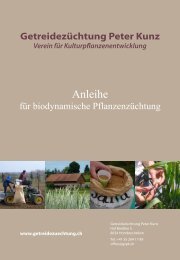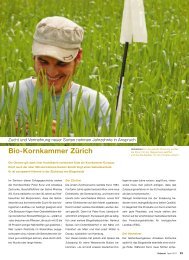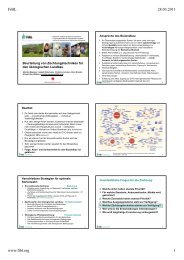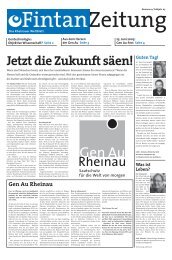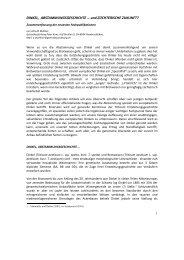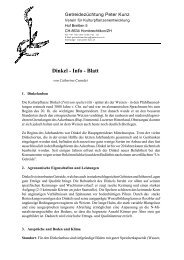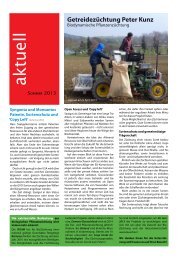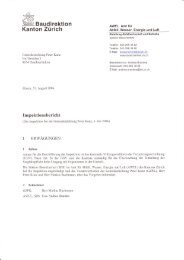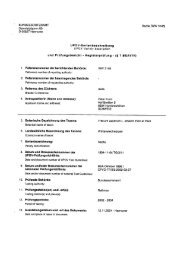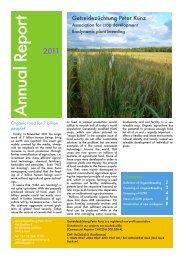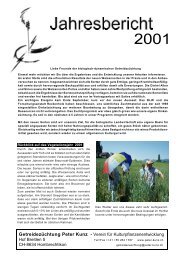update - Getreidezüchtung Peter Kunz
update - Getreidezüchtung Peter Kunz
update - Getreidezüchtung Peter Kunz
Create successful ePaper yourself
Turn your PDF publications into a flip-book with our unique Google optimized e-Paper software.
Biodynamic<br />
Plant Breeding<br />
<strong>update</strong><br />
December 2010<br />
Dear Friends,<br />
As the year draws to its close, we are pleased to offer you an<br />
overview of the current state of our breeding and research<br />
projects. The report is brief; our website provides supplementary<br />
information on many of the topics. Please feel free to call<br />
us with whatever questions you may have!<br />
The vegetation cycle of 2010 was rather peculiar. An extremely<br />
warm and dry spring led to fast crop development. Some<br />
cold and wet months followed, with strong growth mainly of<br />
stalks and leaves. Next, there was another period of heat and<br />
drought, but the first lots were barely ripe when rains set in so<br />
heavily that in many areas the harvest was sprouting on the<br />
ear.<br />
Thanks to three non-stop marathons by two simultaneously<br />
operating threshing teams we just managed to bring in our<br />
experimental plots and bunches of ears before the next rain.<br />
In the end, nearly 100 lots remained in the field and had to be<br />
mulched after the third rainy period.<br />
Discovering and unriddling the secrets of wheat breeding: visitors at Feldbach<br />
on Lake Zurich on our open breeding nursery day, 3 July 2010.<br />
HIGHLIGHTS 2010 – OUTLOOK 2011<br />
1. In spite of very difficult harvesting conditions the Wiwa,<br />
Scaro and Ataro wheat varieties yielded above-average harvest<br />
results. Plant health, quality characteristics and resistance<br />
to sprouting on the ear are stable at a very high level.<br />
2. Our candidate varieties under official trial — Our wheat<br />
AISC.3 and spelt EP1H.22 have shown very good results, as<br />
expected.<br />
3. The new maize project and the sunflower projects for the<br />
breeding of varieties that produce their own seeds have had a<br />
successful start and are now due to be intensified.<br />
4. The cultivation of domestic grain legumes is shrinking dramatically<br />
while the amount of imported soy for protein input<br />
to poultry and pork production keeps expanding. We have<br />
initiated a new project in response to questions regarding<br />
breeding and cultivation.<br />
5. The Zukunftstiftung Landwirtschaft (Foundation for an<br />
Agricultural Future) of GLS Treuhand Bochum celebrated its<br />
10th anniversary. Its Saatgutfonds (Seeds Fund) has been a<br />
long-time financial supporter of GZPK. Best wishes and a great<br />
thank you!<br />
6. Sowing the Future! About 7,500 sowers took part in 77<br />
events in nine countries: Switzerland, Germany, Luxembourg,<br />
Austria, France, Norway, England, the US and South Korea.<br />
Sweden and Italy will join next year.<br />
7. Important dates in 2011:<br />
• Visit us on 24-27 February 2011 at the "Tier und Technik"<br />
(Animals and Technology) exhibition in St Gallen: Special<br />
show Sow Organic Cereals and Harvest the Future. We<br />
are looking forward to your visit, together with BioSuisse,<br />
Sativa Rheinau AG and further partners.<br />
• Seeds Day at Gut Rheinau ZH on Saturday 25 June 2011,<br />
topic: Conversion to Organic Farming.<br />
• Open Breeding Nursery Day on Sunday 26 June 2011 at<br />
Feldbach ZH. Take a look at our seed nurseries, experimental<br />
fields with wheat, spelt, triticale, maize, sunflowers<br />
and grain legumes.<br />
<strong>Getreidezüchtung</strong> <strong>Peter</strong> <strong>Kunz</strong> Telefon +41 55 264 17 89<br />
Verein für Kulturpflanzenentwicklung<br />
Hof Breitlen 5, CH-8634 Hombrechtikon<br />
E-Mail: getreidezuechtung@peter-kunz.ch<br />
www.peter-kunz.ch
A LOOK AT CURRENT PROJECTS<br />
Wheat: <strong>Peter</strong> <strong>Kunz</strong>, Anjana Pregitzer, Agnes Schätzl<br />
We continue with our focus on the selection of high-quality<br />
stable-yield varieties, in accordance with the processors' generally<br />
high requirements and due to the fact that the Wiwa<br />
variety has set new standards in this regard. Candidate AISC.3<br />
has demonstrated the expected high yields during variety<br />
trials with top grain formation and maximum Zeleny values.<br />
This makes it a solid top variety. However, the strong emphasis<br />
on quality characteristics is clearly at the expense of yield<br />
volume. There is an increasing demand for yield-oriented<br />
wheat varieties, particularly from farms in process of conversion.<br />
Feldbach on Lake Zurich has proved to be a suitable site<br />
for the testing of advanced lines. We have therefore re-sited<br />
our breeding nurseries there, allowing<br />
us to be "where the action is" at all<br />
times. Procedures in the emerging<br />
project of Varieties for extensive and<br />
dry habitats have been simplified, to<br />
allow for the assessment of a larger<br />
number of particularly vigorous longstem<br />
"XXL-lines". These are intended to<br />
be equal to the Aszita and Tengri varieties<br />
in yield and quality while outperforming<br />
them in drought resistance.<br />
Increasing attention will be paid to the<br />
selection of red, purple and yellow<br />
grain wheats (see illustration). Several<br />
particular quality traits, like high anthocyanin or vitamin content,<br />
are linked to these extraordinary grain colors. Such particularities<br />
offer attractive features for processing and marketing.<br />
Spelt: Catherine Cuendet, Franca dell‘Avo<br />
During the Biodiversity Year, our focus was on diversity. It was<br />
necessary again and again to point out that this is extremely<br />
limited in the case of spelt. Widening its diversity range thus<br />
remains one of the most prominent breeding goals.<br />
Weather and soil conditions were very difficult, even for<br />
rugged spelt. The crops at Grüningen were weakened by nematode<br />
infestation, a serious handicap for selection. Rheinau,<br />
in contrast, grew a top crop, which confirmed our conviction<br />
that we have very good stock to work from.<br />
There are numerous questions regarding the connection between<br />
wheat and spelt, and the evolutionary history of spelt.<br />
Much new insight has been gained in recent research, and<br />
(European) spelt has been demonstrated to be a very young<br />
cultural achievement, with its origin in Europe! The pertinent<br />
literature has been compiled by Almuth Müllner; a corresponding<br />
report is available on the GZPK website.<br />
The official trial of candidates EP1H.22 and LBA.18 has been<br />
completed; we are now expecting the notification of approval.<br />
Triticale: <strong>Peter</strong> <strong>Kunz</strong>, Agnes Schätzl<br />
Long and vigorous candidate varieties have always shown<br />
convincing results in yield and resistance to sprouting on the<br />
ear. Sativa Rheinau has planted a first small multiplication<br />
plot. If things run according to plan, there will be sufficient<br />
experimental seed available for extensive field tests by fall<br />
2011.<br />
BUNT-RESISTANCE BREEDING: <strong>Peter</strong> <strong>Kunz</strong><br />
Infestation by common bunt or stinking smut is a frequent<br />
problem in wheat as well as in spelt. This project is being continued<br />
in the same range as before. We aim for domestic varieties<br />
that integrate the effective resistance to bunt which is<br />
generally restricted to exotic varieties. For this purpose, 4327<br />
lines resulting from 87 crossings were cultivated and exposed<br />
to powerful infection pressure by artificial inoculation, with a<br />
selection of 2160 healthy plants.<br />
GRAIN LEGUMES: <strong>Peter</strong> <strong>Kunz</strong>, Franca dell‘Avo<br />
This is a new set of topics, initiated in order to counteract the<br />
dramatic decline in the domestic cultivation of protein crops<br />
and the increasing imports of feed soy from South America.<br />
11 varieties of field bean were sown in March, in 3 variants:<br />
unmixed, intercropped with triticale and with oats. The variant<br />
with triticale had the fewest weeds but significantly more<br />
diseased leaves. All the varieties tested grew to between 140<br />
and 230 cm in length and succumbed to a foehn gale in early<br />
June.<br />
For the purpose of pea variety screening, 36 different varieties<br />
were planted, intercropped with the Tomba oat variety.<br />
Two habits could be distinguished: a "leaf type" (with stipules,<br />
tendrils and pinnate leaves) and a "semi-leafless type" (with<br />
stipules, tendrils without pinnate leaves). No major differences<br />
were observed in plant length and inception of blossoming,<br />
however the the pinnate-leaved varieties did worse in stability,<br />
as expected. In a semester project at HSL Zollikofen (an<br />
agricultural college), <strong>Peter</strong> Suter conducted an experiment in<br />
cultivation technology, investigating the question of additional<br />
intercropping partners that might compensate for the pea's<br />
onesidedness. The goal is to improve nitrogen fixation, but the<br />
search is also on for plants that enhance soil fertility. In addition<br />
to the oat, cress and false flax (gold-of-pleasure) were<br />
sown, as well as several types of chicory, ribwort plantain,<br />
carrots and flax. The extremely growth-promoting weather led<br />
to a complete suppression of these smaller plants. The experiment<br />
will be continued in an improved version next year.<br />
Besides the experiments with various varieties, 129 F5-lines of<br />
peas were sown and the best 45 to 50 of these were selected.<br />
HQ-MAIZE FOR POULTRY FEED: <strong>Peter</strong> <strong>Kunz</strong><br />
We are working towards improving the protein quality and<br />
content of maize, in collaboration with Walter Goldstein (Michael<br />
Fields Agricultural Institute East Troy, US). This could<br />
lead to an improvement in the European protein supply for<br />
poultry and thus reduce dependency on overseas soy imports.<br />
The rise in quality we aim for is equally relevant for human<br />
diets. However, the most pressing needs are investments in<br />
breeding (€ 50,000 per year) and analysis (approx. € 100,000).<br />
BIOVERITA VARIETIES FROM ORGANIC BREEDING<br />
Organically bred varieties and products based on these will<br />
carry this logo in the future. It replaces the<br />
emblem of Sativa, as this association has<br />
been dissolved. You will soon be able to<br />
find detailed information regarding the<br />
goals and regulations of Bioverita at bioverita.ch.<br />
GZPK will continue to work on the<br />
basis of biodynamic principles, of course.<br />
Translation: Ueli Hepp - u.hepp@bluewin.ch<br />
Printed on FSC certified paper, produced from responsibly managed forests.
POPULATION VARIETY BREEDING OF SUNFLOWERS AND MAIZE<br />
We consider it extremely important to breed sunflower and<br />
maize population varieties that yield their own seeds for resowing.<br />
On the one hand, it is crucial that farmers can maintain<br />
their independence from the giant seed conglomerates in<br />
a time of increasing market concentration; on the other hand<br />
it is not sufficient to store existing old land varieties in gene<br />
banks for years: in order to represent a realistic alternative to<br />
hybrids and to make their contribution to a variegated, diversified<br />
seed culture, they must be kept alive in a real sense,<br />
developed purposefully or even re-created.<br />
OP – MAIZE BREEDING<br />
OPM 10: <strong>Peter</strong> <strong>Kunz</strong><br />
A limited quantity of experimental seed of the re-sowable<br />
fodder and silage variety will be available under this name<br />
next year, from Sativa Rheinau and from Bioland-<br />
Handelsgesellschaft BW. In its juvenile development OPM 10<br />
is equal to any hybrid variety, even in cool conditions. So far<br />
cob production is lower and will need further improvement.<br />
OP - Mais II: Anjana Pregitzer, Almuth Müllner, <strong>Peter</strong> <strong>Kunz</strong><br />
The "re-edition" of the maize breeding project begun in 2009<br />
aims to intensify current efforts and to make use of recent<br />
progress: We intend to develop two re-sowable types of use<br />
(kernel and silage varieties) and to create a broad-base maize<br />
population that can become a long-term biodiversity pool and<br />
thus serve as the starting point for the development of new<br />
population varieties.<br />
Building on recent years' experience we expect our population<br />
varieties to demonstrate a high performance similar to that of<br />
hybrids. After an intensive preparatory phase — consisting of<br />
screening tests, the determination of genetic relationships<br />
und the assembling of suitable hybrid varieties — the relevant<br />
cross-breeding was done this year, laying the foundations for<br />
new GZPK OP maize varieties.<br />
The project also deals with numerous questions regarding the<br />
development of appropriate methods; it is clear that the<br />
classical procedures of controlled pollination and population<br />
management for open pollination varieties must be further<br />
developed. There is a serious backlog here, research efforts<br />
having concentrated exclusively on advances in hybrid breeding<br />
during the past 50 years.<br />
MULTIPLICATION OF BASIC AND BREEDING SEEDS<br />
The multiplication of breeding seed for Switzerland as well as<br />
all the basic seed multiplication are organized and carried out<br />
by Sativa Rheinau AG www.sative-rheinau.ch. In spite of increasing<br />
demand at home and abroad, the production of basic<br />
seed does not cover its costs. The market for organic seed is<br />
still too small, the multiplication acreage will have to increase<br />
further.<br />
In Germany, seed multiplication is handled by several regional<br />
multiplication organizations and multiplication farms, which<br />
are coordinated by Thomas Leiginger of Bioland Handelsgesellschaft<br />
Baden-Württemberg www.bioland.bw.de. In spite<br />
of the difficult weather conditions during harvest, the germination<br />
capacity of the seed material was very high.<br />
SUNFLOWERS: Robert Ineichen, Florian Burkard, <strong>Peter</strong> <strong>Kunz</strong><br />
Even for organic cultivation the only varieties available are<br />
conventional hybrids from Syngenta or Pioneer. It is the goal<br />
of our sunflower projects to develop practicable alternatives<br />
within 6 to 8 years: re-sowable varieties for three different<br />
purposes. 1. Nutritionally high-grade oil sunflowers for cold<br />
pressing are high in polyunsaturated oleic acids. Their oil has a<br />
correspondingly limited storage life. 2. Oil from "High oleic"<br />
sunflowers contains more than 80% oleic acid; it is stable and<br />
therefore heatable. The use of such oils in frying and in cosmetics<br />
is expanding. Companies like Weleda AG participate in<br />
the project and provide financial and analytical support. 3.<br />
Green manuring is another area where only hybrids are available.—<br />
52 sets of offspring have been evaluated this year, and<br />
300 single-seed descendants were selected for high oleic content<br />
as well as further particular properties.<br />
NO MORE SPONSORING OF SEED MULTI-NATIONALS !<br />
Wherever conventionally bred varieties are deployed or<br />
processed, the giant seed corporations are heavily crossfinanced,<br />
along with their often non-biocompatible goals. For<br />
each hectare of wheat the breeding corporations’ coffers pile<br />
up 10 to 15 Euros, 3 to 4 Euros per ton of processed flour and<br />
about 10 cents for each kg of bread. It would be a big step if<br />
all organic farms and processors asked for organically bred<br />
varieties and participated in their financing. Collaboration<br />
among breeders, cultivators and processors means sharing<br />
the responsibility for the future of our crop plants.<br />
COOP – SUSTAINABILITY FUND<br />
Since 2003 the Swiss COOP bakeries have been processing<br />
organically bred cereals into specialty products and their<br />
Bread of the Month. In addition the COOP Sustainability Fund<br />
has been supporting cereal breeding programs with generous<br />
financial contributions. This has greatly aided the expansion of<br />
GZPK breeding and multiplication programs.<br />
VARIETY PROJECTS IN GERMANY<br />
The 2010 harvest of new varieties has again been warmly<br />
welcomed by millers and bakers; its quality continued to be<br />
above average, while some of the traditional varieties failed<br />
miserably. The tegut-Herzberger bakeries distinguish themselves<br />
with wheat and rye bread that is marked "from biodynamically<br />
bred grain." However, it has not been possible so far<br />
to obtain financial support for the breeding effort that created<br />
the underlying varieties.
SOWING THE FUTURE! — increasingly popular.<br />
There were 77 events in eight countries. About 7,500 sowers<br />
showed the flag for a forward-looking agriculture free of genetic<br />
engineering. Austria, France, Norway and South Korea<br />
had their first sowing events; Switzerland, Germany, Luxembourg,<br />
the UK and the US participated again. The German,<br />
Austrian and Luxembourg events were coordinated by local<br />
Demeter and Bioland organizations. The season closed on 31<br />
October at Feldbach on Lake Zurich, with 75 participants.<br />
Swiss National Councilor Marlies Bänziger (chairperson of the<br />
Zurich Green Party) described sustainable agriculture as an<br />
insufficiently noticed and underappreciated cultural accomplishment<br />
for the benefit of our society. Freedom from genetically<br />
modified crops as a part of Swiss quality production<br />
should be written into law beyond the current moratorium.<br />
The newly designed internet site www.avenirsem.ch offers<br />
global information concerning all Sowing the future! events.<br />
Expenditures will again outbalance revenues from donations<br />
by private persons and foundations. Materials cost a great<br />
amount, and the funding gap is covered by the total accounts<br />
of the promoters, <strong>Getreidezüchtung</strong> <strong>Peter</strong> <strong>Kunz</strong> and the Fondation<br />
L'Aubier Montezilleon www.aubier.ch.<br />
Rounding off the season: the year's final Sowing the future! event took place<br />
on our fields at Feldbach ZH.<br />
GZPK IN-HOUSE: HOF BREITLEN, FELDBACH, COLLABORATORS<br />
The problem of tight quarters has been considerably alleviated<br />
thanks to additional rooms rented from our neighbor.<br />
The new space serves as an office, conference room and<br />
lounge. The Feldbach premises are mainly used for storage<br />
and as a machine depot. The constantly growing operation, in<br />
terms of staff and number of projects, requires some serious<br />
infrastructure planning for the coming years, with corresponding<br />
investments; the space available will soon be insufficient.<br />
We were assisted this year by Markus Johann and Röbi Ineichen,<br />
our interns Jani Leinonen, Mechthild Sonneborn, Anette<br />
Haak and Florian Burkard (who will attend to the sunflowers<br />
next year), and by the many volunteers who supported us<br />
during harvest and in the labs. Patrizia Loggia and Michel<br />
Bossart take some of the office load off <strong>Peter</strong> <strong>Kunz</strong>.<br />
There are still 2 to 3 vacancies for interns for the summer,<br />
either from July to September or from July to October 2011.<br />
BIOSUISSE SUPPORTS BREEDING EFFORTS .<br />
On 17 November the BioSuisse Assembly of Delegates resolved<br />
to make CHF 150,000 available for the support of independent<br />
breeding efforts, in addition to a supportive donation<br />
of CHF 70,000 to GZPK okayed by the BioSuisse Steering<br />
Committee in spring. This clearly illustrates the growing trust<br />
in biodynamic breeding and the increasing appreciation of the<br />
fact that we need to support specific alternatives if we want<br />
to reduce agriculture's massive dependence on the powerful<br />
seed corporations. This is also the first time that an organic<br />
umbrella organization has made a powerful statement about<br />
our common responsibility for the future of crop plants and<br />
domestic animals! We hope these decisions mark the beginning<br />
of a long-lasting productive cooperation.<br />
FUND FOR CROP PLANT DEVELOPMENT<br />
The Fund is recognized as a non-profit institution and aims to<br />
enable long-term financing of ecological breeding projects by<br />
means of donations and bequests. These may be in the form<br />
of financial support or tangible assets. For more information,<br />
see www.fondskulturpflanze.ch or phone 0041 55 264 17 88.<br />
FINANCING THE GZPK: BUDGET 2011<br />
The major worry in the course of this year was the damatic<br />
plunge of the Euro from CHF 1.56 to below 1.30, as a large<br />
portion of our license income and contributions to the Fund<br />
are in this currency. Add to this the negative answers from<br />
potential sponsors of current and future projects, and the<br />
expected income has melted overnight. Staff costs (65% of<br />
total outlay) are clearly below budget by year's end, even<br />
though salary adjustments would have been truly urgent. On<br />
the basis of current accounting data, we expect a deficit.<br />
Total outlay for 2011 is calculated at CHF 755,000<br />
(EUR 580,000) for operating expenses. In addition to salary<br />
adjustments there is a need for infrastructure investments.<br />
Current commitments amount to just under one fifth. Income<br />
from variety licenses represents about 8% of total expenditure.<br />
All this means that GZPK continues to depend crucially<br />
on a continuous flow of donations as well as large contributions<br />
from foundations and endowments, in spite of its remarkable<br />
success. All our projects pursue long-term goals and<br />
are in no way profit-oriented. The additional need for the new<br />
maize, sunflower and grain legume projects is estimated at<br />
CHF 190,000 (EUR 150,000).<br />
For many years over 250 private donors have supported us<br />
faithfully with regular financial contributions. Many hearfelt<br />
thanks to all of you!<br />
DONATION ACCOUNTS OF GETREIDEZÜCHTUNG PETER KUNZ<br />
The association is recognized as non-profit. Commercial Register<br />
Nr CH-020.6.000.558-4. Donations are tax-deductible. You<br />
will receive a donation receipt at the end of the year.<br />
CHF: PC 84-34345-2 Postfinance CH 3030 Bern (ClrNr 09000)<br />
IBAN: CH59 0900 0000 8403 4345 2 / BIC: POFICHBEXXX<br />
EUR: Kto 4013 396 700 (BLZ 430 609 67) GLS Bank Bochum<br />
IBAN: DE47 4306 0967 4013 3967 00 / BIC: GENODEM1GLS<br />
Many thanks for your support!<br />
Hombrechtikon ZH<br />
For administration and team:<br />
31 December 2010 <strong>Peter</strong> <strong>Kunz</strong>



